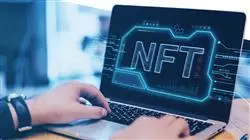University certificate
The world's largest faculty of information technology”
Introduction to the Program
Specialize in the most innovative Asset Digitization tool in the virtual world, with this exclusive TECH program”

With the emergence of the CryptoKitties phenomenon, a set of cryptocurrencies based on Ethereum, the concept of NFTs began to take shape. Hence the idea that demonstrated the potential of representing unique and scarce digital objects in the form of non-fungible tokens. This brings us to the origin of the tokenization of goods, which is closely related to the development of Blockchain technology, more specifically with the popularization of the Ethereum currency.
Since then, Tokenization and NFTs have rapidly expanded to different fields, such as digital art, music, video games, sports and more. Over time, artists, musicians, collectors and creatives started using non-fungible tokens as a way to authenticate and sell their digital works directly to buyers and without intermediaries.
This is why the role of the computer scientist becomes important, since mastery in Tokenization and NFTs is essential in the monetization of assets. For this reason, Professional master’s degree has developed this 12-month Professional master’s degree with advanced and updated content, elaborated by A program that will provide students with a detailed understanding of asset tokenization, from its conceptualization to its commercialization and valuation, giving participants the necessary tools to understand and participate in this constantly evolving field.
For this purpose, Professional master’s degree has developed a program with quality content such as multimedia materials where interactive summaries, quick action guides and specialized readings can be found. In addition, by using the Relearning method, implemented by TECH, the IT professional will advance more fluently in this program, strengthening the new concepts in a simpler way and reducing the extensive hours of study.
An exceptional opportunity that will allow the student to be at the forefront in the Tokenization of rights and will open the doors to better professional opportunities. In addition, you will have the flexibility to coordinate daily activities and work with learning, since you will be able to access from anywhere and at any time just by having an electronic device with network connection.
With this Professional master’s degree in Tokenization and NFTs, you will boost your career and master the new technologies in the Fintech field”
This Professional master’s degree in Tokenization and NFTs contains the most complete and up-to-date academic program on the market. Its most notable features are:
- The development of practical cases presented by experts in finance and Blockchain.
- The graphic, schematic and practical contents of the book provide technical and practical information on those disciplines that are essential for professional practice.
- Practical exercises where self-assessment can be used to improve learning.
- Its special emphasis on innovative methodologies
- Theoretical lessons, questions to the expert, debate forums on controversial topics, and individual reflection assignments
- Content that is accessible from any fixed or portable device with an Internet connection.
Thanks to an innovative syllabus developed by experts, you will be able to access the latest advances in NFTs in the Metaverse”
The program’s teaching staff includes professionals from the sector who contribute their work experience to this training program, as well as renowned specialists from leading societies and prestigious universities.
The multimedia content, developed with the latest educational technology, will provide the professional with situated and contextual learning, i.e., a simulated environment that will provide immersive education programmed to learn in real situations.
This program’s design focuses on Problem-Based Learning, through which the professional must try to solve the different professional practice situations that arise during the academic program. For this purpose, the students will be assisted by an innovative interactive video system created by renowned and experienced experts.
Take advantage of the opportunity to specialize in token valuation and you will open the doors to job opportunities in a constantly growing market"

You will develop skills in Security Tokens and be at the technological forefront in the digital economy"
Why study at TECH?
TECH is the world’s largest online university. With an impressive catalog of more than 14,000 university programs available in 11 languages, it is positioned as a leader in employability, with a 99% job placement rate. In addition, it relies on an enormous faculty of more than 6,000 professors of the highest international renown.

Study at the world's largest online university and guarantee your professional success. The future starts at TECH”
The world’s best online university according to FORBES
The prestigious Forbes magazine, specialized in business and finance, has highlighted TECH as “the world's best online university” This is what they have recently stated in an article in their digital edition in which they echo the success story of this institution, “thanks to the academic offer it provides, the selection of its teaching staff, and an innovative learning method aimed at educating the professionals of the future”
A revolutionary study method, a cutting-edge faculty and a practical focus: the key to TECH's success.
The most complete study plans on the university scene
TECH offers the most complete study plans on the university scene, with syllabuses that cover fundamental concepts and, at the same time, the main scientific advances in their specific scientific areas. In addition, these programs are continuously being updated to guarantee students the academic vanguard and the most in-demand professional skills. In this way, the university's qualifications provide its graduates with a significant advantage to propel their careers to success.
TECH offers the most comprehensive and intensive study plans on the current university scene.
A world-class teaching staff
TECH's teaching staff is made up of more than 6,000 professors with the highest international recognition. Professors, researchers and top executives of multinational companies, including Isaiah Covington, performance coach of the Boston Celtics; Magda Romanska, principal investigator at Harvard MetaLAB; Ignacio Wistumba, chairman of the department of translational molecular pathology at MD Anderson Cancer Center; and D.W. Pine, creative director of TIME magazine, among others.
Internationally renowned experts, specialized in different branches of Health, Technology, Communication and Business, form part of the TECH faculty.
A unique learning method
TECH is the first university to use Relearning in all its programs. It is the best online learning methodology, accredited with international teaching quality certifications, provided by prestigious educational agencies. In addition, this disruptive educational model is complemented with the “Case Method”, thereby setting up a unique online teaching strategy. Innovative teaching resources are also implemented, including detailed videos, infographics and interactive summaries.
TECH combines Relearning and the Case Method in all its university programs to guarantee excellent theoretical and practical learning, studying whenever and wherever you want.
The world's largest online university
TECH is the world’s largest online university. We are the largest educational institution, with the best and widest online educational catalog, one hundred percent online and covering the vast majority of areas of knowledge. We offer a large selection of our own degrees and accredited online undergraduate and postgraduate degrees. In total, more than 14,000 university degrees, in eleven different languages, make us the largest educational largest in the world.
TECH has the world's most extensive catalog of academic and official programs, available in more than 11 languages.
Google Premier Partner
The American technology giant has awarded TECH the Google Google Premier Partner badge. This award, which is only available to 3% of the world's companies, highlights the efficient, flexible and tailored experience that this university provides to students. The recognition as a Google Premier Partner not only accredits the maximum rigor, performance and investment in TECH's digital infrastructures, but also places this university as one of the world's leading technology companies.
Google has positioned TECH in the top 3% of the world's most important technology companies by awarding it its Google Premier Partner badge.
The official online university of the NBA
TECH is the official online university of the NBA. Thanks to our agreement with the biggest league in basketball, we offer our students exclusive university programs, as well as a wide variety of educational resources focused on the business of the league and other areas of the sports industry. Each program is made up of a uniquely designed syllabus and features exceptional guest hosts: professionals with a distinguished sports background who will offer their expertise on the most relevant topics.
TECH has been selected by the NBA, the world's top basketball league, as its official online university.
The top-rated university by its students
Students have positioned TECH as the world's top-rated university on the main review websites, with a highest rating of 4.9 out of 5, obtained from more than 1,000 reviews. These results consolidate TECH as the benchmark university institution at an international level, reflecting the excellence and positive impact of its educational model.” reflecting the excellence and positive impact of its educational model.”
TECH is the world’s top-rated university by its students.
Leaders in employability
TECH has managed to become the leading university in employability. 99% of its students obtain jobs in the academic field they have studied, within one year of completing any of the university's programs. A similar number achieve immediate career enhancement. All this thanks to a study methodology that bases its effectiveness on the acquisition of practical skills, which are absolutely necessary for professional development.
99% of TECH graduates find a job within a year of completing their studies.
Professional Master's Degree in Tokenization and NFTs
Dive into the exciting world of tokenization and NFTs with the Professional Master's Degree in TECH Global University. This online program gives you the opportunity to explore the new frontiers of the digital economy and gain expertise in the fascinating field of non fungible tokens (NFTs) and their application in a variety of industries.
By choosing the Professional Master's Degree in Tokenization and NFTs from TECH Global University, you will benefit from the expertise of a highly qualified teaching team specialized in the field of digital economy. You will have the opportunity to interact with recognized professionals and experts, who will share their knowledge and experience to help you develop practical skills and up-to-date perspectives.
This Professional Master's Degree program will give you an in-depth understanding of the fundamental concepts of tokenization and NFTs, as well as their impact on various sectors, such as art, real estate, music and video games. You will learn about blockchain technology, cryptocurrencies and exchange platforms, and how to apply this knowledge in designing, creating and managing unique and valuable digital assets.
With the Professional Master's Degree in Tokenization and NFTs from TECH Global University, you will be prepared to take advantage of career opportunities in the world of finance and the digital asset-based economy. You'll be able to develop innovative strategies, lead tokenization and NFTs projects, and contribute to the growth and transformation of digital industries.
Online program designed for you
At TECH Global University, our Professional Master's Degree in Tokenization and NFTs is delivered entirely online, giving you the flexibility to study from anywhere and adapt your study schedule to your personal and professional needs.
The online mode of our program gives you access to an interactive virtual platform, where you can participate in real-time classes, access multimedia learning resources and collaborate with professors and classmates on joint projects. This form of study offers you the convenience of learning at your own pace and managing your time efficiently.







